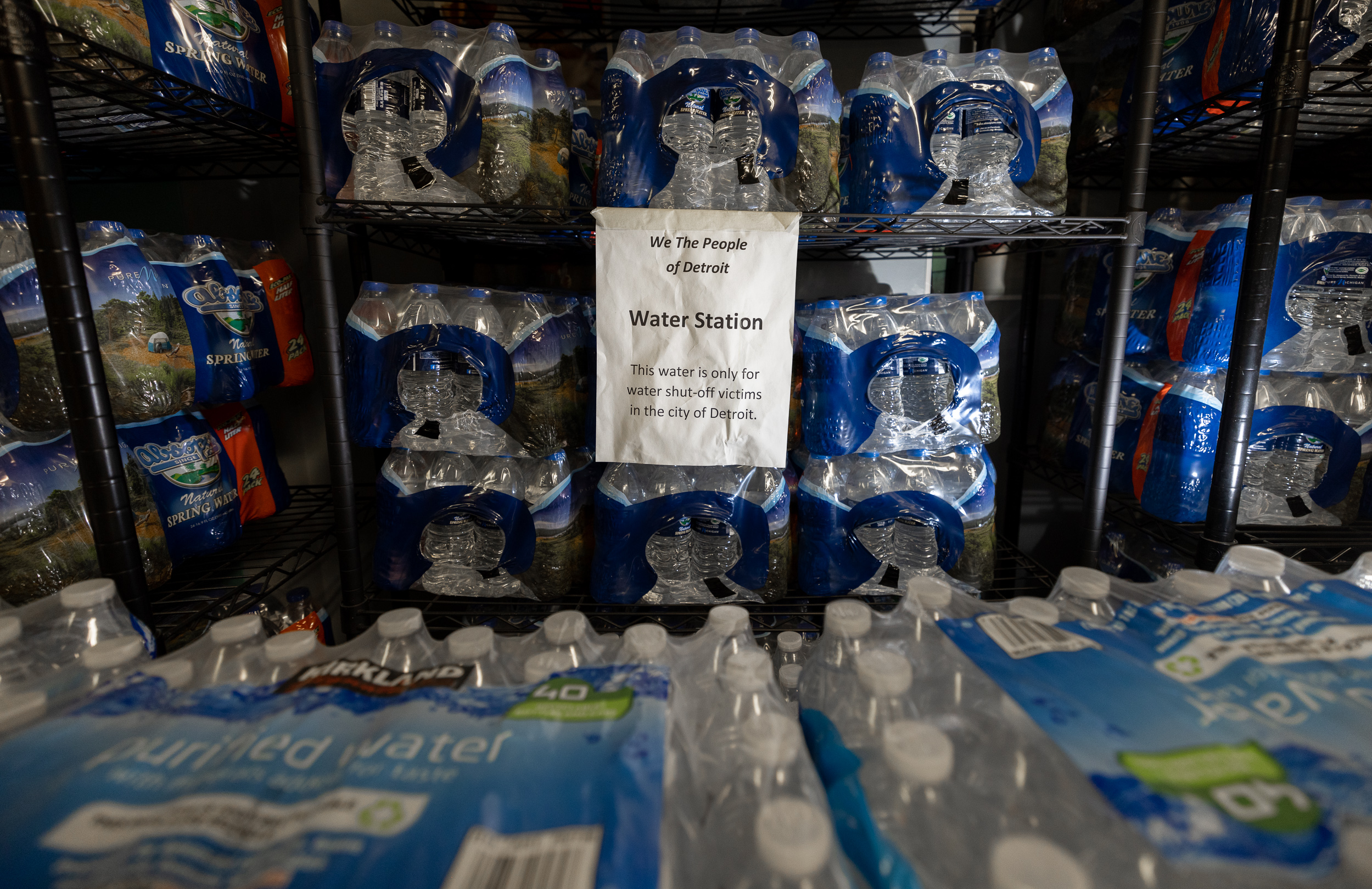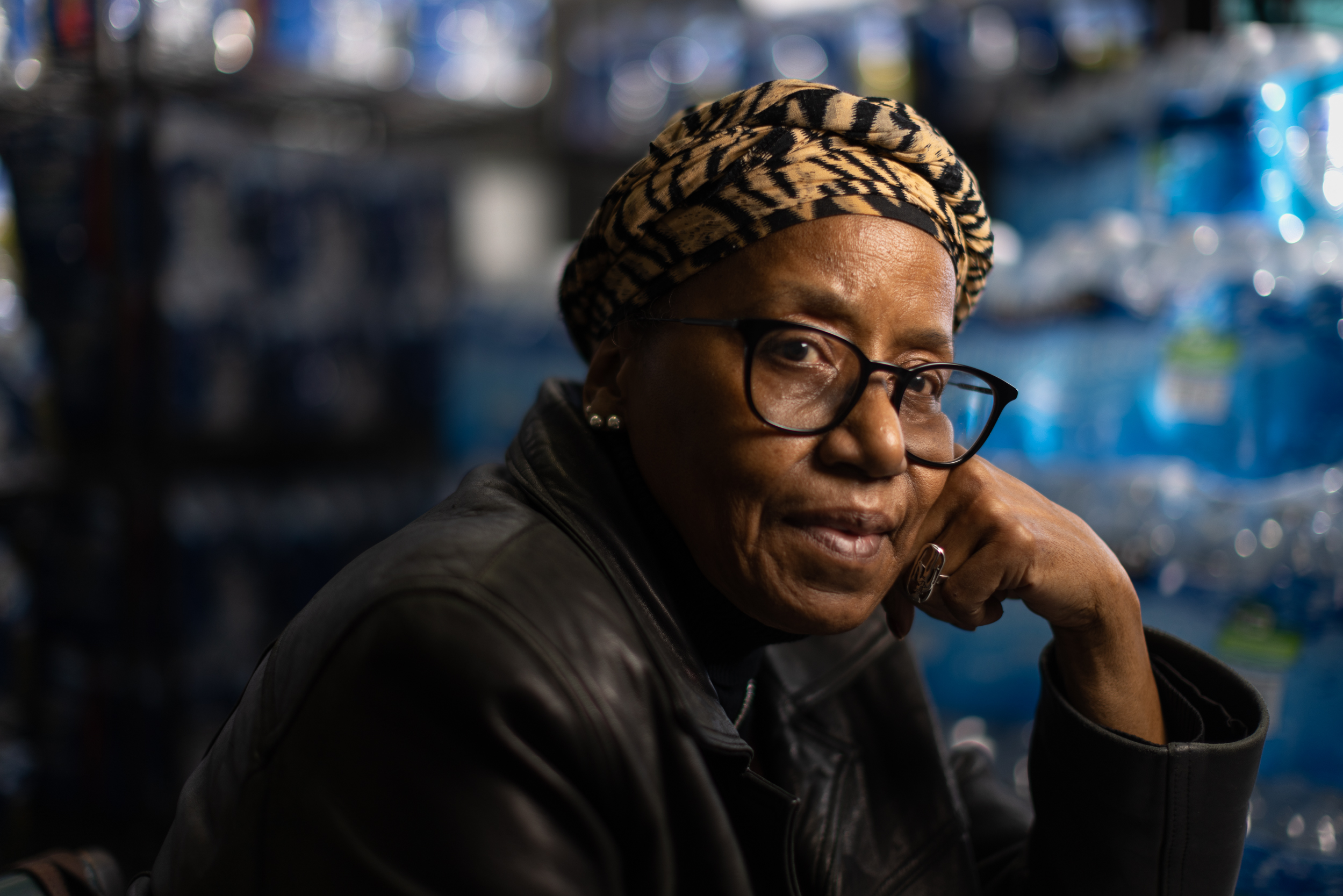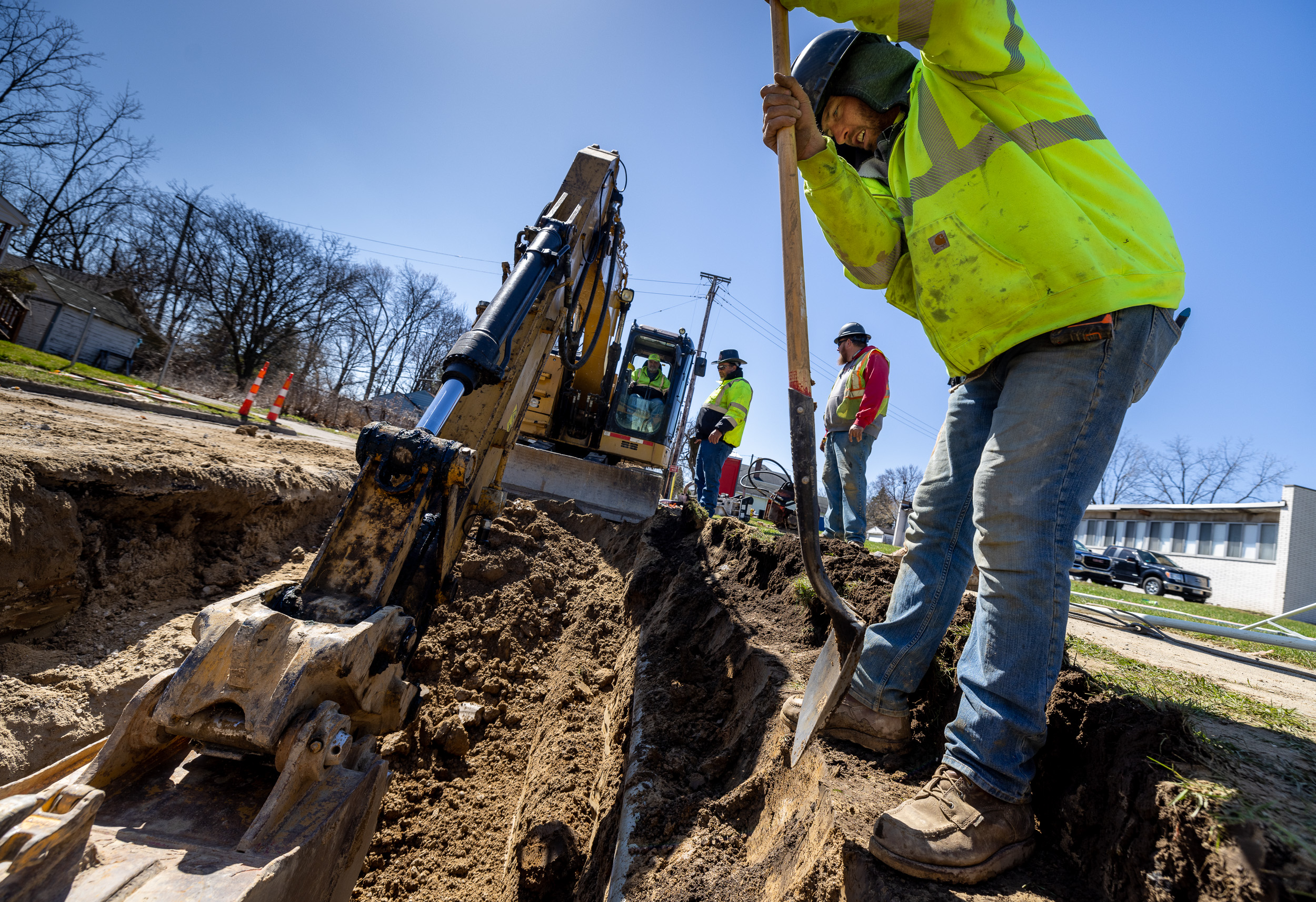
By Brett Walton, Circle of Blue
This story is part of “Water’s True Cost,” a series by the Great Lakes News Collaborative focused on the rising cost of water in Michigan and the various causes leading to the state of water systems today. Find the rest of the stories in the series here.
The questions – the mental calculations for basic needs – are relentless. Can she go another day or two without doing laundry? Do those dishes need to be cleaned now or can they wait until tomorrow or the next day?
Water conservation is a constant negotiation for Summer, a 58-year-old Oak Park resident. Unlike for most people, it’s also a survival strategy.
Summer said she has to be stingy with water to make her monthly budget pencil out. Water, sewer, stormwater, and garbage collection are all part of the same bill. To keep it in the $120 range she washes clothes once a week, sometimes every other week. She receives a fixed income from disability payments. With all her other bills, waste is a luxury she can’t afford.
“Well, it is stressful, of course, because you can’t really live a functional life without water,” said Summer, who did not want her real name to be used in order to keep her personal struggles private. “And you know, it puts you in a scary place, a stressful place, where you’re concerned that your water’s going to go off and if it goes off, you’re going to have to pay all of the reconnection fees.”
Water rates are rising across Michigan as communities undertake long-needed upgrades to hobbled water, sewer, and drainage systems. These are necessary investments for the state’s future that nonetheless are exposing Summer and other low-income households to financial stress.
Data compiled by the Institute for Public Utilities at Michigan State University shows that water prices are climbing quickly – more quickly, until recent price spikes, than most other goods and services. Since the mid-1980s, water prices grew at a higher rate than garbage, electricity, and natural gas, as well as the broader Consumer Price Index, which is a national measure of inflation.
Other studies indicate that public officials should be worried about water price increases and their consequences for the state’s poorest residents. A comprehensive University of Michigan report published last year found that average water prices in the state, when adjusted for inflation, had nearly doubled between 1980 and 2018.

The average cost of water service in Michigan nearly doubled between 1980 and 2018, according to a University of Michigan study that was published in December 2021. The sharpest increase in water costs occurred in cities like Detroit and Flint, which have struggled with aging systems, declining populations, poverty, and disinvestment. (Graphic courtesy of the University of Michigan)
The Michigan chapter of the American Water Works Association, in an informal survey conducted a year ago during the depths of the pandemic, asked its member utilities about past-due bills. The utilities that responded indicated that customers, in aggregate, owed $252 million. Neither the AWWA nor the Michigan Department of Health and Human Services, the agency that is administering the state water assistance program, has updated those numbers.
Urban areas in the state’s southeastern counties, where Oak Park is located, have been particularly hard hit. In the last half-century, Detroit, Flint, Pontiac, River Rouge, Inkster and others had to contend with rising costs, aging systems, declining populations, spendthrift emergency managers, and high poverty rates. But the University of Michigan data also revealed that rising water prices affect every corner of the state, with high-cost pockets in the Thumb and Upper Peninsula.
Water leaders are taking notice.
“Affordability is an issue no matter where you are,” said Jaime Fleming, a board member with the Michigan chapter of the American Water Works Association, a utility group that recently completed a six-month discussion series on affordability. “It’s not just an urban issue. It is a rural issue, with some smaller systems or people that are way out away from a city. We have people struggling all across the state.”
What happens to those people when bills are high and residents cannot afford to pay them? Late fees accumulate, adding to the financial strain. Oak Park residents who receive a shutoff notice in the mail have to pay $10 to the utility for the warning. If the water is shut off, residents pay $90 to get it turned back on – but that fee applies only during regular business hours, Monday to Thursday between 8:00 a.m. and 3:00 p.m. Otherwise residents have to pay a $150 overtime rate. Kevin VanDeWalle, the Oak Park water supervisor, said the fees are designed to pass along the cost of operations.
Neighboring cities also use fees. Shanir Smith, a West Bloomfield resident whose water was shut off in February for past-due bills, said that the three-month payment plan the utility designed for her to catch up has a 9 percent interest rate. “It makes it harder,” Smith said.
Overdue payments can result in a tax lien against the property – another financial penalty that, in Oak Park, comes with a 10 percent fee on the overdue balance. In a rare but worst-case scenario liens can lead to foreclosure. Most often, residents have their water service shut off. Though Michigan placed a moratorium on the practice during the pandemic, utilities can once again turn off water to the home to compel payment.
Though the rising cost of water is a state and national phenomenon, there is no clear-cut definition for affordable water. The concept is complicated because water affordability is relative. It is not only the size of the bill, but how it compares to the income of the household receiving it and to the cost of other essential expenses like food, housing, energy, and healthcare.
For Summer, it’s the combined strain of water, healthcare, and heating bills. She has sarcoidosis, an inflammatory lung disease, and asthma. Her electric bill from DTE Energy is usually around $270 a month. Nights in her home are dim. “I allow the TV to brighten the house as opposed to turning a lot of lights on,” she said.
A Statewide Conundrum
In the broader sense, utility leaders are realizing what advocates from We the People of Detroit and other groups have been saying for years: any attempt to address affordability at the household level means dealing with tangential issues such as the quality of in-home plumbing and fixtures and a utility’s fines and fees. Dripping faucets and pipe leaks can cause bills to unexpectedly spike. High charges that utilities apply to late payments can put financially struggling people like Shanir Smith farther behind.
“We’re seeing that more communities now are understanding the water security needs that they have among certain subsets of their customer base, and that they can’t solve the problem on their own,” said Sylvia Orduño, a community organizer for the Michigan Welfare Rights Organization, which advocates for low-income households.
Despite the complexity, public officials and researchers have several guidelines to frame the affordability discussion. The United Nations suggests an affordability threshold of 5 percent of income. The Philadelphia Water Department, in its income-based billing program, caps water bills for enrollees at between 2 and 4 percent of household income. Manny Teodoro of the University of Wisconsin has pioneered two ways of measuring affordability. One compares water costs to hours worked at minimum wage. The other divides water costs over household income minus essential expenses.
The University of Michigan study described the trends in Michigan in these terms. The number of households paying more than 5 percent of income for water and sewer bills more than quadrupled since 1980.

Cecily McClellan is co-founder of We the People of Detroit and directs the “water works” program, which provides water to Detroit area residents who can’t afford it. “When people can’t afford water, it becomes a health issue,” she said, “that affects the most vulnerable, especially young mothers.” (Photo Credit: J. Carl Ganter/Circle of Blue)
To Michigan’s advocacy groups, concerns about water prices are not new. The Michigan Welfare Rights Organization, working with the economist Roger Colton, developed an alternative billing structure in 2005 for Detroit’s poorest residents. The income-based billing system, in which people would pay a percent of their income for water, was not adopted in Detroit, even as the city shut off water in the following decade to tens of thousands of people with past-due water bills. An income-based billing system was eventually embraced in a different city: Philadelphia, which debuted its Tiered Assistance Program in 2017, on the order of the City Council. The program also gave residents a pathway to eliminate their water bill debt, a feature endorsed by Michigan advocates as well.
More attention to the problem of high bills has resulted in more opportunities to assist people. The 112 communities who receive water from the Great Lakes Water Authority are eligible, if they sign up, for the Water Rate Assistance Program, or WRAP.
Barbara Jackson is the deputy director of welcome center services for the Oakland-Livingston Human Services Agency, the agency that administers WRAP for Oakland County.
Jackson sees high demand for assistance. In six years, the program has delivered $21.6 million to 22,000 households.
“Water is such a necessity, such a necessity, and people don’t even realize it until you don’t really have it,” Jackson said.
The program comes at the problem from multiple angles. Enrolled households – those making less than 200 percent of the federal poverty line – $55,500 for a family of four – can receive up to $1,200 to pay off overdue bills. A second option is to receive a monthly bill credit of $25 per month. The third approach focuses on reducing water demands through conservation. The program provides up to $2,000 for plumbing repairs. City councils select which options they want to offer. Some opt only for bill credits and conservation.
There could be other assistance models soon in southeast Michigan. The Detroit Water and Sewerage Department is developing its own water affordability plan. Bryan Peckinpaugh, the department’s public affairs director, said that the plan would take a “multi-pronged approach,” but he was not willing to provide more details.
In Oakland County, the water resources commission is completing a state-funded water affordability plan for two communities, Pontiac and Royal Oak Township. Jim Nash, the water resources commissioner, said the goal is two-fold: to help people who find an average bill to be a financial burden and to develop a program to assist people in emergency situations, such as job loss.
“Everything we do that can make it easier on them paying their bill will make it less likely that they’ll miss a bill, and if they do, they can get assistance right away,” Nash said.
The proposal, which has not been finalized, will aim for something similar to Philadelphia’s income-based rate, Nash said. Any assistance program will have to clear legal hurdles like the Headlee amendment, which limits the ability of local governments to raise taxes. Nash believes the county is on sound legal ground.
The details are still being developed but households at the bottom rung of the economic ladder – those making half the poverty rate – would have a fixed monthly bill of $30 or $35. People at the poverty rate would pay a little more, perhaps $45 per month. An average bill in Pontiac is about $80 per month, so the discount would be significant. The Water Resources Commission is still fiddling with the numbers, but Nash hopes it could be a blueprint for other cities.

A crew from Pamar Enterprises, Inc., replaces a water main in Pontiac, Michigan. (Photo Credit: J. Carl Ganter/Circle of Blue)
A Plea for Outside Help
How could cash-strapped utilities that are already struggling to maintain their water systems afford that? Many Michigan communities do not have the resources of GLWA or larger cities. Smaller and poorer districts may have trouble just keeping their operations afloat, let alone provide financial support to the bulk of their residents. There is no statewide data on how many residents have access to customer assistance programs, either through their utility or another community organization.
Local water leaders say the financial imbalance between utility revenue needs and the struggle for some customers to afford their bills can only be solved by outside funding. By that, they mean state or federal dollars.
The pandemic opened the door to that possibility. For more than four decades, the federal government has funded a program to assist households with home heating and electricity bills. But until last year, there was no comparable program for water. The energy bill assistance program, called LIHEAP for short, was established in 1981, following a period of financial stress related to soaring oil prices due to turmoil in Iran and Iraq, both major producers.
The federal water bill assistance program, called LIHWAP, was also born in an emergency – widespread worries about water access and public health during the pandemic.
Congress appropriated $1.1 billion to get the program started, allowing the money to cover past-due bills or reduce future payments. Of that sum, which was split between states, tribes, and territories, Michigan received $36.2 million.
It’s a drop in the bucket compared to the need. Nor are means-tested federal programs a cure-all. The funds flow through third-party community action agencies, meaning extra paperwork that is burdensome for small utilities as well as households. These programs also help a small fraction of the people who are eligible. The energy bill assistance program reaches only one-sixth of its potential audience.
Even so, does the long-term success of a water affordability program depend on state and federal dollars?
Jim Nash was adamant that outside support is necessary. Wealthier communities in Oakland County like Farmington Hills probably have the resources, he said. Those communities may have only a few percent of households that need bill assistance. For communities with a much larger share of financially struggling households, they cannot achieve it on their own. Nash said that 35 percent of households in Pontiac and 55 percent in Royal Oak Township pay more than 4 percent of their income on water and sewer bills.
“We want to have local water systems do as much as they can,” Nash explained. “But the state and federal government should be helping us do that because they’re the ones that should be guaranteeing the rights of Americans.”
Nash supports the creation of a $100 million state fund for water utilities to tap into. It’s a message he’ll take to Lansing when Oakland County files the final affordability plan report by September.
“We can’t just put all the burden on the local ratepayers,” Nash said. “It just can’t work in the long term. It’s not sustainable.”
Non-Government to the Rescue
Earlier this year, Summer found herself in an unwelcome situation. She was about $340 behind on her water bill payments to Oak Park. If the past-due balance exceeded $500 the city would start looking to cut off service. Her water had never been shut off and she wanted to avoid that.
Summer applied for emergency assistance through the Department of Health and Human Services, but was denied. She could not recall the reason. In previous financial struggles, family members had chipped in, but they weren’t able to do so this time, she said.
As Summer grew nervous, another door opened. A caseworker mentioned The Human Utility, a nonprofit that assists low-income people in the Detroit metro area who need help with water bills.
Staff at The Human Utility acted fast. Within two days of providing her information, Summer received a donation of $321.51, taking care of nearly all her past-due balance and allowing her to relax.
“I was completely shocked,” she said, full of praise for the speed and professionalism with which The Human Utility helped her.
Summer is now applying for a work-from-home job that is not too physically taxing for her lung conditions. She’ll have to be careful about how the hours fit with the disability program requirements, but a new income source would provide some flexibility.
“Hopefully I’ll be successful,” she said. “And if I am, you know, I can supplement my income and hopefully get out of the situation where I’m stressing first of every month.”
Catch more news at Great Lakes Now:
Billions Flow to Water Systems from Federal Pandemic Relief Funds
Risky Drinking Water Pathogen Has Outsized Effect on Black Americans
After Decades of Neglect, Bill Coming Due for Michigan’s Water Infrastructure
Featured image: Cases of bottled water at St. Peter’s Episcopal Church are stacked and ready to be distributed to low-income households by We the People of Detroit. Residents can call the group’s water crisis hotline for help with overdue water bills. (Photo Credit: J. Carl Ganter/Circle of Blue)




